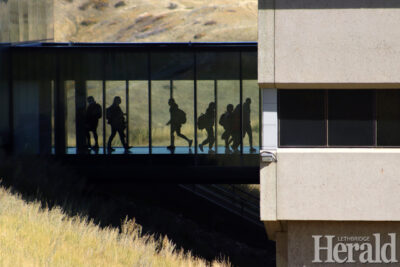University conference focuses on work integrated learning
By Al Beeber - Lethbridge Herald on October 4, 2024.
 Herald photo by Al Beeber
Students traverse a walkway at the University of Lethbridge on Thursday.
Herald photo by Al Beeber
Students traverse a walkway at the University of Lethbridge on Thursday.LETHBRIDGE HERALDabeeber@lethbridgeherald.com
Educators, academic and industry leaders and students gathered in the Science Commons Atrium at the University of Lethbridge on Thursday afternoon for the fifth annual STEM Fusion conference.
The conference was a partnership among the University of Lethbridge, Lethbridge Polytechnic and the City of Lethbridge.
The conference connects science, technology, engineering and mathematics professions with commercialization, innovation and entrepreneurship, says the university.
This year’s theme was work integrated learning which provided a way for industry and academic leaders to network and form new connections and collaborations while learning what local businesses are doing to integrate WIL into their operations.
Luc Roberts, an entrepreneurial strategist with the University of Lethbridge Teaching Centre and Agility, said before the conference started that “STEM Fusion is an event that is put on every year. It initially had a focus, as it would imply, connecting STEM – science, technology, engineering and mathematics – to industry. This year, we’ve focused on work integrated learning.”
The purpose is for different partners to come together to get students involved in their education to have experiential learning. It was a way for students to get a hands-on experience rather than just being in the classroom.
“It’s a chance to learn about ways to integrate it into their degree, this is a chance for industry to show their ways and attract students for work integrated learning terms and also an opportunity to just for everyone to present some of the work that’s being done through some work integrated learning” and research,” said Roberts.
Between industry and students, the conference had 130 registrants.
Perry Stein of the City of Lethbridge said the City does a lot of work with the university and polytechnic around work integrated learning, bringing students into applied research projects.
“There’s a direct relationship between students doing work integrated learning and experiential learning and graduate retention. This is a way of helping students seek a future in this community, job opportunities, community engagement.”
And students doing research projects with the City helps it to do its work even better, he added.
“It’s all a win for us,” Stein said.
With 15,000 undergraduate students in Lethbridge – almost 15 per cent of the city’s population, it’s a demographic that needs attention, said Stein.
Stacey Gaudette-Sharp, academic director of the Career Bridge Centre at the university, said it’s wonderful in her work that she gets to collaborate with the other people at the conference, “helping students to understand that the University of Lethbridge is really approaching their education from a holistic perspective and that they should think about their professional and academic and personal development all at the same time.”
And collaborating with conference partners is “a really amazing way to bring together opportunities to support student learning.
“When we have industry folks and educators get together, it’s usually magic,” said Gaudette-Sharp.
WIL has been popular in other areas of the country and Alberta is catching up, Gaudette-Sharp said.
“It’s a winning combination in terms of getting students the best kind of transformational education and also just having amazing impacts on the community.”
Erin Kaipainen, director of Work Integrated Learning of the University of Calgary who also serves on the national association for WIL, says WIL has been around “since the beginning of time” for some disciplines such as nursing and teaching.
“What’s new is the focus on having all students participate in work integrated learning ideally at least once in their undergraduate or degree program so that they’re graduating with experience.
“But it’s also a process of discovery and learning,” said Kaipainen, who was the first of her family to attend university.
“I have these really funny ideas about the world of work and for me that first work integrated learning experience was really providing career clarity,” Kaipainen added.
“I could work in a university setting” where she had never considered a path.
“It gave me access to mentorship that I’d never had before being first in family to attend post-secondary education. So really it’s a hands-on way for students to discover their passions, to grow, to experience and to grow their networks as they prepare for their next steps, all the while contributing to the city, the community organizations that they’re working with, Kaipainen added.
26-25


